词汇学 教案 Chapter 5-7
- 格式:doc
- 大小:82.50 KB
- 文档页数:10
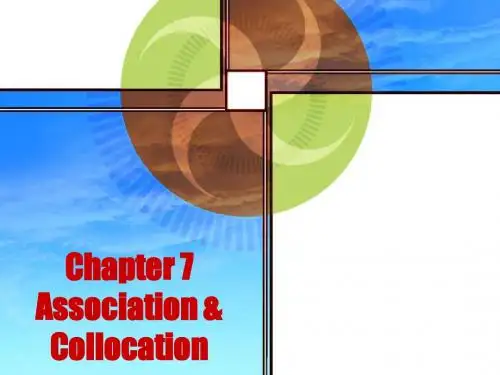
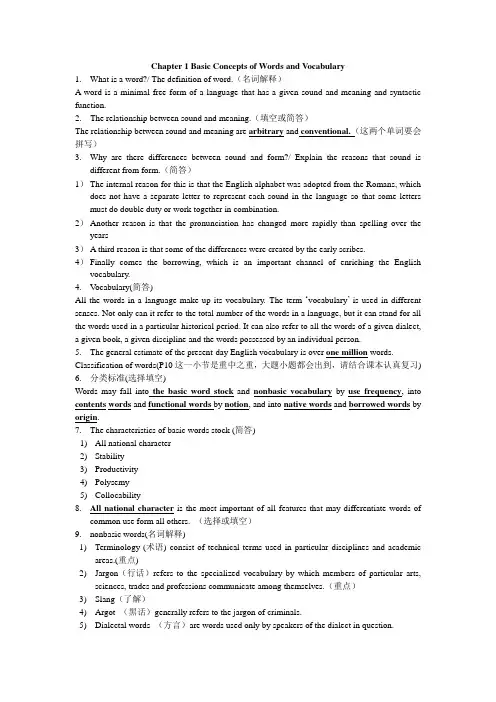
Chapter 1 Basic Concepts of Words and Vocabulary1.What is a word?/ The definition of word.(名词解释)A word is a minimal free form of a language that has a given sound and meaning and syntactic function.2. The relationship between sound and meaning.(填空或简答)The relationship between sound and meaning are arbitrary and conventional. (这两个单词要会拼写)3.Why are there differences between sound and form?/ Explain the reasons that sound isdifferent from form.(简答)1)The internal reason for this is that the English alphabet was adopted from the Romans, which does not have a separate letter to represent each sound in the language so that some letters must do double duty or work together in combination.2)Another reason is that the pronunciation has changed more rapidly than spelling over the years3)A third reason is that some of the differences were created by the early scribes.4)Finally comes the borrowing, which is an important channel of enriching the English vocabulary.4.V ocabulary(简答)All the words in a language make up its vocabulary. The term ‘vocabulary’ is used in different senses. Not only can it refer to the total number of the words in a language, but it can stand for all the words used in a particular historical period. It can also refer to all the words of a given dialect,a given book, a given discipline and the words possessed by an individual person.5.The general estimate of the present-day English vocabulary is over one million words. Classification of words(P10这一小节是重中之重,大题小题都会出到,请结合课本认真复习)6.分类标准(选择填空)Words may fall into the basic word stock and nonbasic vocabulary by use frequency, into contents words and functional words by notion, and into native words and borrowed words by origin.7.The characteristics of basic words stock (简答)1)All national character2)Stability3)Productivity4)Polysemy5)Collocability8.All national character is the most important of all features that may differentiate words ofcommon use form all others. (选择或填空)9.nonbasic words(名词解释)1)Terminology (术语) consist of technical terms used in particular disciplines and academicareas.(重点)2)Jargon(行话)refers to the specialized vocabulary by which members of particular arts,sciences, trades and professions communicate among themselves.(重点)3)Slang(了解)4)Argot (黑话)generally refers to the jargon of criminals.5)Dialectal words (方言)are words used only by speakers of the dialect in question.6)Archaisms (古语)are words or forms that were once in common use but are now restrictedonly to specialized or limited use.7)Neologisms(新词)are newly-created words or expressions, or words that have taken onnew meanings.(重点)10.Content words denote clear notions and thus are known as notional words. (名词解释或填空)11.Functional words do not have notions of their own. (名词解释或填空)12.Content words include nouns, verbs, adjectives, adverbs and numerals.13.Functional words are also called empty words or form words. They include prepositions,conjunctions, auxiliaries, articles and pronouns.14.the functions of native words:Native words form the mainstream of the basic word stock and stand at the core of the language. Therefore, what is true of the basic word stock is also true of native words.15.Apart from the characteristics mentioned of the basic word stock, in contrast to borrowedwords, native words have two other features: (选择填空或简答)1)Neutral in style2)Frequent in use 要注意native words一共有5+2=7个特点16.外来语的分类:(选择填空或简答)According to the degree of assimilation and manner of borrowing, we can bring the loan-words under four classes.1)denizens2)aliens3)Translation-loans4)Semantic-loans17.Denizens are words borrowed early in the past and now well assimilated into the Englishlanguage. (名词解释)18.Aliens are borrowed words which have retained their original pronunciation and spelling. (名词解释)19.课本第20页练习中的选择、判断、填空都要仔细看,可能会出到原题Chapter 2 The Development of The English Vocabulary1.英语的三个发展阶段及其时间(简答,填空,选择,三个阶段及其时间都要记住)1)Old English (450-1150)2)Middle English (1150-1500)3)Modern English (1500-up to now)2.Now people generally refer to Anglo-Saxon as Old English (选择,填空)3.Old English has a vocabulary of about 50,000 to 60,000words. It was highly inflectedlanguage just like modern German. (古英语的特点,选择,填空)4.Middle English retained much fewer inflection. If we say that Old English was a fullendings, Middle English was one of leveled endings.(中期英语的特点,选择,填空)5.In modern English, word endings were mostly lost with just a few exceptions. It can beconcluded that English has evolved from a synthetic language (Old English) to the present analytic language. (现代英语的特点,选择,填空)6.There are three main sources of new words:1)the rapid development of modern science and technology2)social, economic and political changes3)the influence of other cultures and languages7.Modes of vocabulary development (重点,简答)1)Creation2)Semantic change3)Borrowing8.Creation is the most important way of vocabulary expansion.9.第33页课后题中的天空、判断好好看看Chapter 3 Word Formation 11.morpheme: the morpheme is ‘the smallest functioning unit in the composition of words.’ (名词解释)2.allomorphs: Some morphemes are realized by more than one morph according to theirposition in a word. Such alternative morphs are known as allomorphs.(名词解释)3.types of morphemes (要求会画42页的表)4.free morpheme: Morphemes which are independent of other morphemes are considered to befree. (名词解释)5.We might see that free morphemes are free root.6.bound morphemes: morphemes which cannot occur as separate words are bound. (名词解释)7.bound root: a bound root is that part of the word that carries the fundamental meaning just likea free root. It is a bound form and has to combine with other morphemes to make words. (名词解释)8.what is affixes? Illustrate it with examples. 论述题,这是个重点,课本第41页整页,按上课时画的来回答9. A root is the basic form of a word which cannot be further analyzed withhold total loss ofidentity. (名词解释)10.A stem may consist of a single root morpheme as in iron or of two root morphemes as in acompound like handcuff. It can be a root morpheme plus one or more affixational morphemes as in mouthful, underestimate.11.we will use stem only because it can replace root and also refer to any form which is largerthan a root.12.第44页课后题三个都要好好看一下Unit 4 Word Formation II1.The expansion of vocabulary in modern English depends chiefly on word-formation. Themost productive are affixation, compounding and conversation.(选择,填空)2.Affixation is generally defined as the formation of words by adding word-forming orderivation affixes to stems. This process is also known as derivation. (名词解释)3.Prefixation is the formation of new words by adding prefixes to stems. (名词解释)4.Prefixes do not generally change the word-class of the stem but only modify its meaning.(前缀的特点)5.We classify prefixes on a semantic basis into nine groups:1)Negative prefixes:2)Reversative prefixes3)Pejorative prefixes: mal-, mis-, pseudo-4)Prefixes of degree or size5)Prefixes of orientation and attitude6)Locative prefixes7)Prefixes of time and order8)Number prefixes9)Miscellaneous prefixes(这九种及其例子都要记住,选择题给出例子要知道是属于哪种前缀)6.Suffixes is the formation of new words by adding suffixes to stems. (名词解释)7.Suffixes has only a small semantic role, their primary function being to change thegrammatical function of stems. In other words, they mainly change the word class. (后缀的特点)8.记住几种后缀及其例子,给出一个后缀要选出是什么意义的后缀pounding: Compounding, also called composition, is the formation of new words byjoining two or more stems. Words formed in this way are called compoundings.(名词解释)pounds can be written solid, hyphenated and open.11.Characteristics of compounds/ The differences between compounds and free words (简答)1)Phonetic features2)Semantic features3)Grammatical features12.动词复合词的两种构成形式:(简答)1)Conversation2)Backformation13.Conversation is the formation of new words by conversation words of one class to anotherclass. (名词解释)14.短语动词转换成名词的两种方法:1)Words like hand-out, stand-by are all converted from phrasal verbs. Such conversation isvery common in English. The examples cited here keep their original order, hand-out from hand out, stand-by from stand by.2)Sometimes, when a phrasal verb is turned into a noun, the verb and particle should beinverted.15. Characteristics of full conversation: a noun fully converted from an adjective has all the characteristics of nouns. It can take an indefinite article or –(e) to indicate singular or plural number.16. 熟记以下例子,给出例子,要知道是属于完全转类,一般出选择题或判断题:Common adjectives:a white; a native; finals; drinkables; a liberal; a Republican; necessaries; valuablesParticiples and others:a given; a drunk; young marrieds; newly-weds17. Characteristics of words partially conversation:Nouns partially converted from adjectives do not possess all the qualities a noun does. They must be used together with definite articles. What’s more, they retain some of the adjective features18. 部分转类例子(同16)the poor, the rich, the young, the wounded, the poorer, the more affluent, the most corrupt19. Blending is the formation of new words by combining parts of two words or a word plus a part of another word. (名词解释)20. Four groups of blends(简答)1) head + tail2) head +head3) head +word4) word +tail21. examples: (选择或判断,要求同前)motel (head + tail)sitcom(head + head)medicare (head +word)22. clipping is to shorten a longer word by cutting a part off the original and using what remains instead. (名词解释)23. Four common types of clipping (简答)1) Front clipping2) Back clipping3) Front and back clipping4) Phrase clipping24. examples(要求同前)quake, phone (front clipping)flu, fridge, (front and back clipping)pub, pop, zoo (phrase clipping)25. Acronymy is the process of forming new words by joining the initial letters of names of social and political organizations or special noun phrases and technical terms.(名词解释)26. Initialisms are words pronounced letter by letter. (首字母缩略词)Acronyms are words formed from initial letters but pronounced as a normal word. (首字母拼音词)27. examples:VOA, c/o, p.c. TV (Initialisms)AIDS, N-bomb (Acronyms)28. Back-formation is the method of creating words by removing the supposed suffixes.(名词解释)29. examples:donate, beggar, babysitter (back-formation)30. Words from Proper Names include names of people, names of places, names of books and trade names.31. examples:Faraday, Ohm, Volta, Quixote (names of people)China (names of places)Utopia, odyssey, Babbit (names of books)Nylon, orlon, Dacron, rayon (trdaenames)31.课本第73页练习,选择,填空和判断都要仔细看Chapter 5 Word Meaning1.Reference is the relationship between language and the world. (名词解释)2.Concept, which is beyond language, is the result of human cognition, reflecting the objectiveworld in the human mind. It is universal to all men alike regardless of culture, race, language and so on whereas meaning belongs to language, so is restricted to language use. (名词解释)3.Sense denotes the relationships inside the language. (名词解释)4.注意1、2、3的区别5.Motivation accounts for the connection between the linguistic symbol and its meaning. As weknow, the relationship between the word-form and meaning is conventional and arbitrary, and most words can be said to be non-motivated. That is, the connection of the sign and meaning does not have a logical explanation. Nevertheless, English does not have words whose meanings can be explained to a certain extent. (名词解释或简答)6.Four motivations:(简答)1)Onomatopoeic motivation (拟声理据)2)Morphological motivation (形态理据)3)Semantic motivation (语义理据)4)Etymological motivation (词源理据)7.types of meaning 要会画表8.grammatical meanings refers to that part of the meaning of the word which indicatesgrammatical concept or relationships such as part of speech of words (nouns, verbs, adjectives, adverbs), singular and plural meaning of nouns, tense meaning of verbs and their inflectional forms. (名词解释)9.Lexical meaning and grammatical meaning make up the word-meaning. It is known thatgrammatical meaning surfaces only in use. But lexical meaning is constant in all the content words within or without context as it is related to the notion that the word conveys. Lexical meaning itself has two components: conceptual meaning and associative meaning.10.Conceptual meaning (also known as denotative meaning ) is the meaning given in thedictionary and forms the core of word-meaning. (名词解释)11.概念意义的特点:constant and relatively stable12.Associative meaning is the secondary meaning supplemented to the conceptual meaning. (名词解释)13.four types of associative meaning: connotative, stylistic, affective and collective.(填空,选择或简答)14.connotative meaning refers to the overtones or associations suggested by the conceptualmeaning. (名词解释)15.stylistic meaning: Apart from their conceptual meanings, many words have stylistic features,which make them appropriate for different contexts. (名词解释)16.stylistic meaning normally classify into formal, neural and informal.17.examples:domicile (very formal, official) residence(formal)abode(poetic)home(general)diminutive (very formal) tiny (colloquial)wee(colloquial, dialectal)记住这些例子,要知道这些是说的词的”stylistic meaning”18.affective meaning: Affective meaning indicated the speaker’s attitude towards the person orthing in question. (名词解释)19.Words that have emotive values may fall into two categories: appreciative or pejorative.20.collocative meaning: this meaning consists of the associations a word acquires in itscollocation.21.课本第92页课后题选择,填空,判断Chapter 6 Sense Relations and Semantic Field1.论述题(按课堂上讲答)Please illustrate two approaches to polysemy with examples.The problem of interrelation of the various meanings of the same word can be dealt with from two different angles: diachronic approach and synchronic approach.2.The development of word-meaning from monosemy to polysemy follows two courses,traditionally known as radiation and concatenation.3.Homonyms are generally defined as words different in meaning but either identical both insound and spelling or identical only in sound or spelling. (名词解释)4.Types of Homonyms (简答)1)Perfect homonyms2)Homographs3)Homophones5.Perfect homonyms are identical both in sound and spelling, but different in meaning. (名词解释)6.Homographs are words identical only in spelling but different in sound and meaning. (名词解释)7.Homophones are words identical only in sound but different in spelling and meaning. (名词解释)8.Homophones constitute the largest number and the most common. (填空或选择)9.Origins of Homonyms (简答)1)Change in sound and spelling2)Borrowing3)Shortening10.Differentiation of Homonyms from Polysemants (难点,这个课本上整段都要仔细看,不一定会出什么形式的题)Perfect homonyms and polysemants are fully identical with regard to spelling and pronunciation. This creates the problem of differentiation. 1) The fundamental difference between homonyms and polysemants lies in the fact that the former refers to different words which happen to share the same form and the latter is the one and same word which has several distinguishable meanings. 2) One important criterion is to see their etymology. 3) The second principle consideration is semantic relatedness. 4) In dictionaries, a polysemant have meanings all listed under one headword whereas homonyms are listed as separate entries. 11.Synonyms: one of two or more words in the English language which have the same or verynearly the same essential meaning. In other words, synonyms share a likeness in denotation as well as I part of speech. (名词解释)12.Synonyms can be classified into two major groups: absolute synonyms and relativesynonyms.13.Absolute synonyms: Absolute synonyms also known as complete synonyms are words shichare identical in meaning in all its aspects, i.e. both in grammatical meaning and lexical meaning, including conceptual and associative meaning.14.Discrimination of synonyms:(论述或简答,注意如果出简答题,则不用举例子,直接答每一段的前一句话就行,但如果是论述,以下都答)The differences between synonyms boil down to three areas: denotation, connotation, and application.1)Difference in denotation. Synonyms may differ in the range and intensity ofmeaning. For example,timid and timorous are synonymous, but the former isapplied to both the state of mind in which a person may happen to be at the moment,and to the habitual disposition, and the latter only to the disposition. Therefore,timid has a wider range of meaning than timorous.2)Difference in connotation. By connotation we mean the stylistic and emotivecoloring of words. For example, among the group of policeman, constable, bobbyand cop. Policeman and constable are stylistically neutral, yet the former is usedboth in British English and American English while the latter is only British. B obbyis colloquial, used only in British English and cop is slangy.3)Difference in application. Many words are synonymous in meaning but different inusage in simple terms. They form different collocations and fit into differentsentence patterns. For example, answer and let are synonyms, but we allow sb to dosth and let sb do sth.15.Antonymy (同上题,简答或论述,另外这里面的例子要记住,选择填空或判断中出现要知道属于哪一类反义词)Antonymy is concerned with semantic opposition. Antonyms can be defined as words which are opposite in meaning. There are a variety of ‘oppositeness’. They can be classified into three major groups.1)Contradictory terms. These antonyms truly represent oppositeness of meaning. Theyare so opposed to each other that they are mutually exclusive and admit nopossibility between them. The assertion of one is the denial of the other. In otherwords, if one of the pair is true, then the other cannot be. For example, an animal iseither dead or alive, and there exists no such a case where the animal is both deadand alive. The same is applicable to present/absent, male/female, boy/girl, true/false,same/different and so on.2)Contrary terms. Antonyms of this type are best viewed in terms of a scale runningbetween two poles or extremes. Antonyms such as rich/poor, old/young, big/smallrepresent two points at both ends of the pole. The two opposites are gradable andone exists in comparison with the other. (other examples: old/young, open/close,rich/poor, hot/cold, beautiful /ugly这几个答大题是不用写,小题时认识就行)3)Relative terms. This third type consist of relational opposites such as parent/child,husband/wife, predecessor/successor, employer/employee, sell/buy, give/recive. 16.Hyponymy 这部分题量不多,记住其中的例子,可能会出选择、填空或判断,比如flower是rose 的什么词?答案:superordiante17.Semantic field这一部分也是出小题,比如给出一堆蔬菜名称,问这是什么语义场,答案a field of vegetable. 或者其他的语义场,fruit, color, relatives and so on.仔细看一下课本上的例子18.课本123页课后题,选择,填空,判断Chapter 7 Changes in Word Meaning1.Word-meaning changes by modes of extension, narrowing, degradation, elevation, andtransfer. Of these, extension and narrowing by far the most common.2.Extension is a process by which a word which originally had a specialized meaning has nowbecome generalized. (名词解释)3.Narrowing is a process by which a word of wide meaning acquires a narrower or specializedsense. (名词解释)4.examples: meat, wife, girl (例子要求同前)5.Elevation refers to the process by which words rise from humble beginnings to position ofimportance. (名词解释)6.Degradation or pejoration of meaning is the opposition of semantic elevation. It is processwhereby of good origins fall into ill reputation or non-affective words come to be used in derogatory sense.(名词解释)7.examples: silly, knave, criticize8.Transfer: words which were used to designate one thing but later changed to mean somethingelse have experienced the process of semantic transfer.(名词解释)9.causes of changes (简答)1)Extra-linguistic factorsa.historical reasonb.class reasonc.psychological reason2) Linguistic factorsa. shortening of phrasesb. borrowingc. analogyChapter 8 Meaning and Context1.linguistic context : Context is used in different sense. In a narrow sense, it refers to the words,clauses, sentences in which a word appears. This is known as linguistic context, which may cover a paragraph, a whole chapter and even the entire book. (名词解释)2.extra-linguistic context: Context is used in different sense in a broad sense, it includes thephysical situation as well. This is called extra-linguistic or non-linguistic context, which embraces the people, time, place, and even the whole cultural background. (名词解释)3.Linguistic context can be subdivided into lexical context and grammatical context.4.Lexical context refers to the words that occur together with the word in question. Themeaning of the word is often affected and defined by the neighboring words.(名词解释)5.Grammatical context: In some case, the meaning of a word may be influenced by the structurein which it occurs. This is what we call grammatical context. (名词解释)6.The role of context: (简答)1)elimination of ambiguity2)indication of referents3)provision of clues for inferring word meaning7.Ambiguity often arises due to polysemy, homonymy and grammatical structure.8.课后习题Chapter 9 English Idioms1. Characteristics of idioms(简答)1)semantic unity2)structural stability2. Please explain the structural stability of idioms(简答)1) The constituents of idioms cannot be replaced.2) The word order cannot be inverted or changed.3) The constituents of an idiom cannot be deleted or added to, not even an article.4) Many idioms are grammatically unanalysable.3. According to grammatical functions we classify idioms into five groups.4. Idioms can be classified into 5 groups: (简答)1) Idioms nominal in nature2) Idioms adjectival in nature3) Idioms verbal in nature4) Idioms adverbial in nature5) Sentence idioms5. Idioms nominal in nature: Idioms of this class have a noun as the key word in each and function as a noun in sentences. (名词解释)6. Idioms verbal in nature can be divided into phrasal verbs and verb phrases.7. Phrasal verbs are idioms which are composed of a verb plus a prep and/or a particle. (名词解释)8. As far as sentence types are concerned, sentence idioms embrace declarative, interrogative, imperative and exclamative sentences. In terms of complexity they can be further divided into simple, compound and complex sentences.9. Idioms are generally felt to be informal.10. Apart from the stylistic features, idioms manifest apparent rhetorical colouring in such respects as of phonetic manipulation, lexical manipulation and figures of speech. (填空或简答)11. Phonetic manipulation: (1) Alliteration (2) Rhyme12. 应用举例:eat like a horse -----simileBlack sheep, a dark horse------metaphor13. Metonymy: This refers to idioms in which the name of one thing is used for that of another associated with it. (名词解释)14. 课本179页练习,选择,填空,判断,简答。
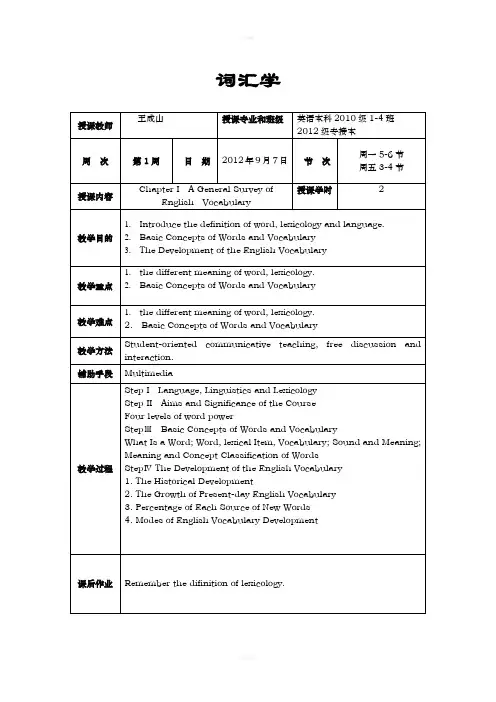
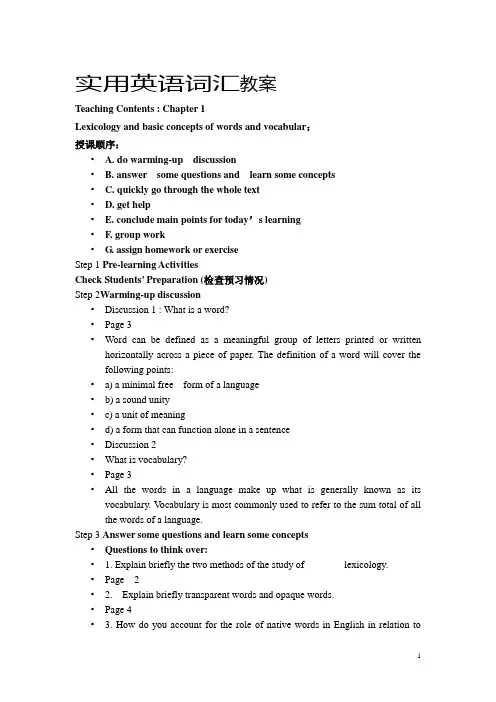
实用英语词汇教案Teaching Contents : Chapter 1Lexicology and basic concepts of words and vocabular:授课顺序:• A. do warming-up discussion• B. answer some questions and learn some concepts• C. quickly go through the whole text• D. get help• E. conclude main points for today’s learning• F. group work•G. assign homework or exerciseStep 1 Pre-learning ActivitiesCheck Students’ Preparation (检查预习情况)Step 2Warming-up discussion•Discussion 1 : What is a word?•Page 3•Word can be defined as a meaningful group of letters printed or written horizontally across a piece of paper. The definition of a word will cover the following points:•a) a minimal free form of a language•b) a sound unity•c) a unit of meaning•d) a form that can function alone in a sentence•Discussion 2•What is vocabulary?•Page 3•All the words in a language make up what is generally known as its vocabulary. V ocabulary is most commonly used to refer to the sum total of all the words of a language.Step 3 Answer some questions and learn some concepts•Questions to think over:• 1. Explain briefly the two methods of the study of lexicology.•Page 2• 2. Explain briefly transparent words and opaque words.•Page 4• 3. How do you account for the role of native words in English in relation toloan-words?•page 4 and page 133•Questions to think over:• 4. What are the classifications of words?(如何分类单词)•Page 3-4•1) full words and form words•2) popular word and learned word•3) abstract word and concrete word•4) transparent word and opaque words•5) polysemic word and monosemic word•6) native word and loan word•Concepts to learn:•Lexicology Page 1•Lexicology, as the science of words, is a branch of linguistics, inquiring into the origins and meanings of words. English lexicology aims at investigating and studying the morphological structures of English words and word equivalents, their semantic structures, relations, historical development, formation, and usages.• 2. word•(We learned just now!)• 3. vocabulary•(We also learned just now!)Step 4 Go through the whole text• 1.1 The definition of lexicology• 1.1.1 The domains of English lexicology•First…Secondly…•Thirdly…Lastly…• 1.1.2 Methods of study of lexicology• 1.2 The definition of word• 1.3 The definition of vocabulary• 1.4 Classification of wordsStep 5Helping time for solving problems.Put up your hand and let me know if you still don’t understand the text. I will come to help !!Step 6 Conclude main points for today’s learning•Main points for today• 1. the definition of English lexicology•Page 1• 2. the domains of English lexicology•Page 1• 3. methods of study of lexicology•Page 2• 4. the definition of word•Page 35. the definition of vocabulary•Page 3• 6. Classification of words•Page 3---4Step 7Group work•Discussing, writing and speaking :•Work in groups of threes or fours and think over and write on the topic Why Should a Chinese Student of English Study English Lexicology? When the group is ready, please choose one student to represent the group to make a presentation in front of the class.(先进行小组讨论,然后选一位代表来到台前陈述小组的想法和讨论结果。
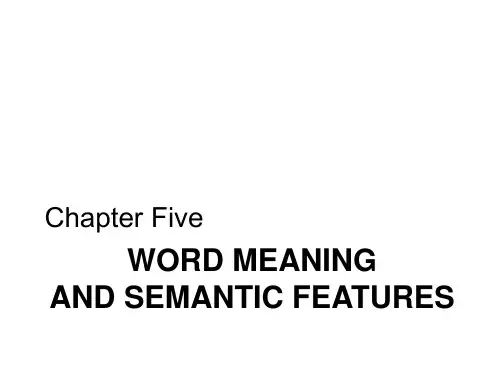
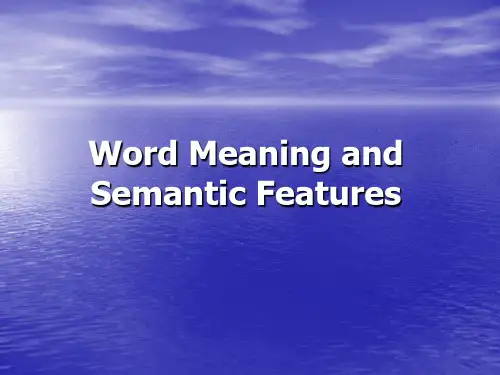
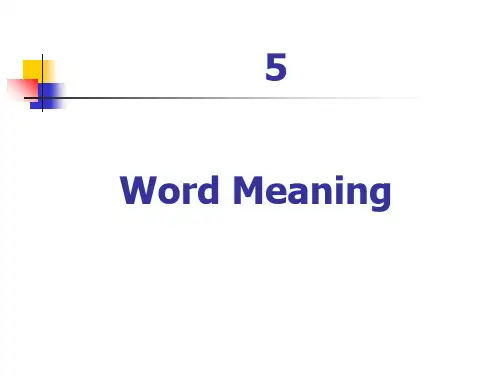
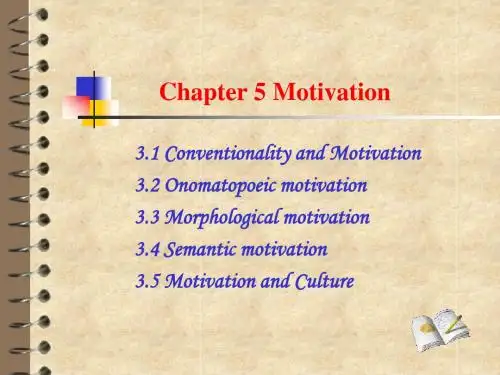
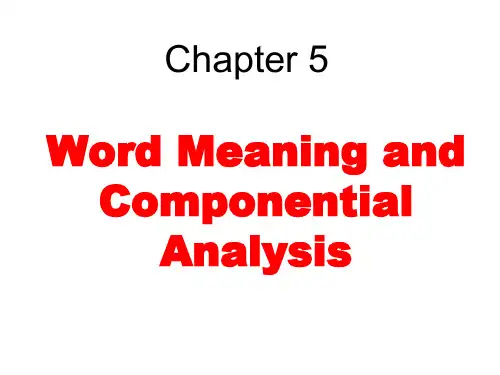
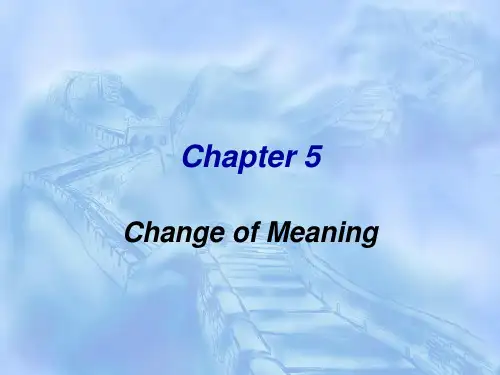
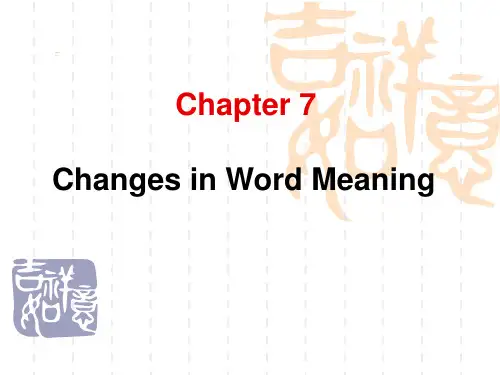
《词汇学》课程教学大纲适用专业:对外汉语、汉语言文学专业学时:36先修课程:古代汉语现代汉语一、本课程的地位和作用汉语词汇学,与文字学、音韵学、训诂学、语法学都是汉语言专业的一门专业课,是有关汉语的重要内容之一。
通过汉语词汇学这门课程的学习,使学生初步了解并掌握古代汉语词汇方面的初步知识及古代汉语词汇的一般特点,了解古今汉语词汇方面的内在联系,为今后从事汉语教学和进一步研究汉语词汇打下扎实的基础。
二、本课程的教学目标本课程的开设,主要是为培养学生了解古今汉语词汇的语音特点、意义和一般用法,从汉语词汇知识中吸取营养,充实自己,在现实生活的语言交流和交际之中正确运用汉语的词汇。
同时,也为进一步研究汉语词汇打基础。
三、课程内容和基本要求汉语词汇学的主要内容和基础知识,主要是研究汉语词汇的类别、词的语音特征、词的语音形式、演变及其规律,词汇的构成和构成方式、词义及词义特点、词义的演变、古今词义的异同、词的同义反义现象、同类词、同源词、同音词,词汇研究的方式、手段、词汇学史等方面的内容,要求对这些知识有个一般的了解和基本的掌握,最好能够运用这些知识去研究汉语中所出现的具体的语言现象。
第一章序论一、词汇学的对象和分科1、任何语言都有自己的语音系统、词汇和语法构造,语言的这三个组成部分在语言学上都有相应的学科来进行研究。
词汇学就是其中以词和词汇作为研究对象的一门学科。
所谓词汇就是语言里的词和词的等价物(如固定词组)的总和。
词汇中包括实词和虚词,词汇学的研究重点是实词。
因为有的虚词词汇意义已经弱化,有的甚至完全失去了词汇意义,只剩下语法意义,所以它们主要是语法学研究的对象。
2、在中国语言学史上,词汇的研究比语音和语法的研究都开始得早,这就是所谓训诂”。
最古的一部训诂书《尔雅》写成于西汉时代。
到了清朝乾嘉时代。
训诂学更有了高度的发展,段玉裁(1735--1815)、王念孙(1744--1832),王引之(1766--1834)等人把这门学问推进到了一个崭新的历史阶段。
Chapter 5 Word Meaning and Componential Analysis5.1 Word Meaning1. What is ‘word meaning’?Word meaning can be defined as a reciprocal relation between name and meaning. ‘Meaning’ is what the form stands for.Eg: desk: something you sit at and you do your workThere are two aspects to the meaning of a word: denotation and connotation. The process by which the word refers to the referent is called "denotation". For example, the denotation of "dog" is "canine quadruped". The denotative meaning of a word usually refers to the dictionary definition of a word. As opposed to denotation, connotation refers to the emotional aspect of a word. For example, the connotation of "dog" might include "friend", "helper", "competition", etc.2. What is reference?It is the relationship between language and the world. By means of reference, a speaker indicates which things in the world (including persons) are being talked about. In other words, only when a connection has been established between the linguistic sign and a referent, i.e., an object, a phenomenon, a person, etc. does the sign become meaningful.The reference of a word to a thing outside the language is arbitrary and conventional.3. What is concept?It is the general idea or meaning which is associate with a word or symbol in a person’s mind.What’s the relationship between meaning and concept?1)They are both related directly to referents and are notions of the words butbelong to different categories.2)Concept, which is beyond language, is the result of human cognition,reflecting the objective world in the human mind. Concept is universal to all men alike regardless of culture, race, and language and so on.3)But meaning belongs to language, so is restricted to language use. A conceptcan have as many referring expressions as there are languages in the world.Even in the same language, the same concept can be expressed in different words.Meaning is closely related to a concept, but they are not identical. A concept is the base of the meaning of a word. A word is used to label a concept. It acts as the symbol for that concept. The concept is abstracted from the person, thing, relationship, idea, event, and so on, that we are thinking about. We call this the referent. The word labels the concept, which is abstracted from the referent; the word denotes the referent, but does not label it. This approach to meaning can be diagrammed as follows: word - concept – referentThe formula shows that the word refers to the referent through a concept.A concept is an abstraction from things of the same kind.4. What is sense?The sense of an expression is its place in a system of semantic relationships withother expressions in the language.What’s the difference between reference and sense?1) Sense denotes the relationships inside the language.2) Every word that has meaning has sense but not every word has reference.5.2 Motivation1. What is motivation?Motivation deals with the connection between name and sense2. Types of motivationA. Onomatopoeic MotivationIt means the imitation of sounds by sounds. Onomatopoeia is derived from Greek onomatopoeia "word-making": onoma, -matos "name" + poieo "make". Various other terms have been suggested, such as echoism (Jespersen) and "phonaesthetic function" (Firth). Onomatopoeic motivation means defining the principle of motivation by sound. The sounds of such words as cuckoo, ding-dong, swish, buzz, seem to be appropriate to their senses. For examples: p101But it has to be pointed out that onomatopoeic words constitute only a small part of the vocabulary. The forms of words normally have only a conventional relationship with what they refer to. According to Stephen Ullmann, onomatopoeic formation can be divided into primary onomatopoeia and secondary onomatopoeia.B. Morphological motivationWords which were formed by means of morphological structure belong to the category of motivation by morphology.C. Semantic MotivationSemantic motivation means that motivation is based on semantic factors. It is a kind of mental association. When we speak of the bonnet or the hood of a car, of a coat of paint, or of potatoes cooked in their jackets, these expressions are motivated by the similarity between the garments and the objects referred to. In the same way, when we say the cloth for the clergy, silk for a Q. C., or "town and gown" for "town and university", there is semantic motivation due to the fact that the garments in question are closely associated with the persons they designate. Both types of expression are figurative: the former are metaphorical, based on some similarity between the two elements, the latter are metonymic, founded on some external connection.1) MetaphorMetaphor is a figure of speech containing an implied comparison, in which a word or phrase ordinarily and primarily used of one thing is applied to another, as in "He has a heart of stone.", "The curtain of night has fallen."2) MetonymyMetonymy is the device in which we name something by one of its attributes, as in crown for king, the turf for horse-racing, the White House for the President.3) SynecdocheSynecdoche means using a part for a whole, an individual for a class, a material for a thing or the reverse of any of these - for example, bread for food, the army for a soldier, copper for penny.D. Etymological motivationEtymological motivation denotes that the origins of words often throw light on their meanings.E.g.: Pen originally refers to ‘a heavy quill or feather’. Today the writing tool is still “pen”, but a meaning is not exac tly the same as what it used to mean.5.3 Motivation and cultural backgroundWords that epitomizes cultural history are called culturally-bound words or allusive words. A culturally-bound word condenses a fund of meanings into a shorter term. "Quixotic", for example, is an epitome of a great book by Cervantes. The word derived from Don Quixote, the hero of the satirical romance, has come to mean "extravagantly chivalrous or romantically idealistic; visionary; impractical or impracticable". Another example is the Faustian spirit: that heaven-storming, adventurous thirst for the infinite which led Faust to sell his soul to the devil in return for universal knowledge and experience.The spiritual history not merely of a decade, but of a whole epoch may be summed up in an allusive word. Sometimes a great poet, a dramatist or a novelist gives a name to the spirit of an age - as Goethe did with Faust, Shakespeare with Hamlet. Even a poet's own name may come to express a quality and temper for which we have no other single word. Virgilian Pity, for example, carries a wealth of meaning: poignant, sensitive sadness over the tragedy implicit in most human life; the feeling of regret over vanished beauty and the doom visited on great-hearted courage in the face of malign destiny.Culturally-bound words present a challenge to anyone who likes to bring history up into the vivid present.5.4 Types of meaningWord meaning is made up of various components which are interrelated and interdependent. These components are commonly described as types of meaning. Types of Meaning: Grammatical Meaning & Lexical MeaningLexical Meaning: Conceptual Meaning & Associative MeaningAssociative Meaning: Connotative Meaning & Stylistic Meaning & Affective Meaning & Collocative Meaning1.Grammatical Meaning & Lexical Meaning1)Grammatical meaning indicates grammatical concept or relationships such aspart of speech of words, singular and plural meaning of nouns, tense meaning of verbs and their inflectional paradigm.2)Lexical meaning is the meaning of an isolated word in a dictionary. Thiscomponent of meaning is identical in all the forms of the word.2.Conceptual Meaning & Associative Meaning1)Conceptual meaning is meaning given in the dictionary and forms the core ofword meaning.2)Associative meaning is the secondary meaning supplemented to theconceptual meaning. It differs from the conceptual meaning in that it is open-ended and indeterminate, liable to the influence of such factors as culture, experience, religion, etc.a. Connotative MeaningIt refers to the overtones or associations suggested by the conceptual meaning. What connotations do you think “home”,and “mother” might have?b. Stylistic MeaningIn some dictionaries, these stylistic features are clearly marked as ‘formal, i nformal, literary, archaic, slang’ and so on.c. Affective MeaningAffective meaning expresses the speaker’s attitude towards the person or thing in question. Words that have emotive values may fall into two categories: appreciative and pejorative/derogative. Words of positive overtones are used to show appreciation or the attitude of approval; those of negative connotations imply disapproval, contempt or criticism.d. Collocative MeaningIt is that part of the word meaning suggested by the words with which it co-occurs. Pretty and handsome share common ground in the meaning "good-looking", but may be distinguished by the range of nouns with which they are likely to co-occur.5.5 Componential Analysis1. What is componential analysis?The analysis of word meanings/componential analysis is often seen as a process of breaking down the sense of a word into its minimal components, which are known as semantic features or sense components. Componential analysis is on the basis of semantic contrast. The linguistic meaning of a word is the set of abstracted characteristics necessary to distinguish the category which the word names from all other categories. These abstracted characteristics are known as semantic features. Semantic features are used to describe semantic universals that may characterize all languages.Semantic features are established on the basis of binary opposition.. Eg: +ADULT (adult), - ADULT (young).Sense components are conventionally enclosed in square brackets or parenthesis or without. They are all written in capital letters or in small letters with the letter in capital to distinguish them from lexical items.man [ +MALE, +ADULT, +HUMAN]woman [ -MALE, +ADULT, +HUMAN]boy [ +MALE, -ADULT, +HUMAN]girl [ - MALE, -ADULT, +HUMAN]bullock [+MALE, +ADULT, - HUMAN]cow [ - MALE, +ADULT, - HUMAN]In making componential analysis, it is important to focus on the distinguishing features, i.e. features which can distinguish one word from another.Eg: Between boy, chair, dictionary and hope, thought, problem, the distinguish feature is [+CONCRETE]2. The advantages and disadvantages of componential analysis.Chapter 6 Sense Relation6.1 PolysemyThe same word may have two or more different meanings. This is known as "polesemy"; such a word is "polesemic". The word "flight", for example, may mean "passing through the air", "power of flying", "air of journey", "unit of the Air Force", "volley", "digression", "series of steps", etc.1. Two approaches to polysemy1) Diachronic approach: It is assumed to be the result of growth and development of the semantic structure of one and same word. The first meaning is the primary meaning. Later meanings are called derived meanings.2) Synchronic approach: Synchronically, polysemy is viewed as the coexistence of various meanings of the same word in a historical period of time. The basic meaning of a word is called the central meaning. The derived meanings are secondary in comparison.2. Sources of polesemyPolesemy can arise in a number of ways. According to Stephen Ullmann, there are five sources. But here we will confine ourselves to the examination of the three most important ones, since the other two (Homonyms Reinterpreted and Foreign Influence) are rare or not quite normal in English.A. Shifts in applicationB. Specialization in a social milieuC. Figurative language3. Two processes of development1) Radiation 2) Concatenation1) RadiationSemantically, radiation is the process which the primary or central meaning stands at the center while secondary meanings radiate from it in every direction like rays. All the meanings are independent of one another, but can all be traced back to the central meaning.2) ConcatenationAnother process, as opposed to radiation, is called "concatenation". It means that a word moves gradually away from its original sense as a result of successive semantic changes until, in many cases, there is not a trace of connection between the sense that is finally developed and the primary sense.A good example is "candidate". The word derived from the Latin candidates which originally meant "a person dressed in white"; then, "a white-robed seeker for office", from the Roman custom of wearing one's freshest robes when asking the suffrages of the people. In the current use of "candidate", the idea of "white attire" has completely disappeared, leaving only the sense of "an applicant for office", which has no obvious connection with the primary meaning of the word.6.2 HomonymyHomonyms are generally defined as words different in meaning but either identical both in sound and spelling or identical only in sound or spelling.1. Types of homonyms: perfect/absolute homonyms; homographs; homophones. Of the three types, homophones constitute the largest number and are most common.2. Origins of homonyms: change in sound and spelling; borrowing; shortening3. Differentiation of homonyms from polysemants4. Rhetoric features of homonyms(1) --Why should a man never tell his secrets in a cornfield?--Because it has so many ears.(2) On Sunday they pray for you and on Monday they prey on you.From the above examples, we can see that homonyms are often employed to create puns for desired effect of humor or irony for stylistic purposes.6.3SynonymySynonymy is a term used in semantics to refer to a major type of sense relation between lexical items: lexical items which have the same meaning but differ in morphemic structure, phonological form and usage are synonyms, and the relationship between them is one of synonymy.1.Definition of synonymsSynonyms are words different in sound and spelling but most nearly alike or exactly the same in meaning.Synonyms share a likeness in denotation as well as part of speech, for a verb cannot have an adjective as its synonym.2. Types of synonyms1) Absolute synonymsAbsolute synonyms are words whose meaning is fully identical in any context so that one can always be substituted for the other without the slightest change in meaning.2) Relative synonymsSynonyms which denote different shades of meaning or different degrees of a given quality are called relative synonyms.3. Sources of synonyms1)BorrowingEnglish is particularly rich in synonyms for the historical reason that its vocabulary has come from two different sources, from Anglo-Saxon on the one hand and from French, Latin and Greek on the other. Since English is considered to be a Germanic language from a historical point of view, with Anglo-Saxon as an earlier stage of its development, the "Anglo-Saxon" words are often considered to be "native" while those from French, Latin or Greek are "foreign", "borrowed" from these languages. Examples of this kind can be divided into types:Doublets:Native Words Borrowed Wordsbrotherly fraternalbodily corporalhomely domestichouse mansionTriplets:Anglo-Saxon French Latinkingly royal regaltime age epochrise mount ascendfast firm secure2) Dialects and regional English3) Figurative and euphemistic use of words4) Coincidence with idiomatic expressions4. Discrimination of synonymsTo sum up, the differences between synonyms may boil down to three areas: denotation, connotation, and application.1)Difference in range and intensity of meaning2)Difference in stylistic features3)Difference in emotive coloring4)Difference in application6.4 Antonymy1. Types of AntonymsThe term "antonymy" is used for "oppositeness of meaning"; words that are in opposition are antonyms.1) Antonyms classified on the basis of the morphological structureTraditionally words that are opposite in meaning are classified into root (or absolute) antonyms and derivational antonyms. Root antonyms are words of different roots, e.g. clear - vague, large - small, happiness - sadness, up - down, etc. Derivational antonyms are words of the same roots with negative affixes (mostly prefixes) added to them, e. g. pleasant - unpleasant, polite - impolite, honest - dishonest, pre-war - post-war, useful - useless, hopeful - hopeless, etc.2) Antonyms classified on the basis of semantic contrastA. ContrariesContraries (or contrary terms) show a type of oppositeness of meaning, illustrated by such pairs as wide/narrow, old/young, big/ small, etc. They can be seen in terms of degrees of the quality involved. Thus a road may be wide or very wide and one road may be wider than another. This shows that the semantic polarity in contraries is relative and the opposition is gradual.Sapir handled contrary terms in terms of gradability. This means that contraries can be placed at both extremes of a scale, between which there may be gradable lexical items. For example, between the antonymic pair beautiful - ugly, there may be such gradable adjectives as pretty - good-looking - plain. One may also grade the intensity of feeling as in love - attachment - liking - indifference - antipathy - hate. It can be seen from above that contraries always imply comparison with some norm. Contraries are also known as graded antonyms.B. ComplementariesComplementaries (or complementary terms) represent a type of binary semantic contrast which admits of no gradability between the items, e. g. male/female, boy/girl, single/married, etc. Male is said to be "the complementary of" female, and vice versa. In such a relationship, the assertion of one of the items implies the denial of the other.C. ConversivesConversives (or converse terms) display a type of oppositeness of meaning,illustrated by such as buy - sell, give - receive, parent - child, debtor - creditor, above - below, etc. Buy is said to be "the converse of" sell and vice versa: If A sells a watch to B, B buys a watch from A. The same applies to the pair above - below: If A is above B, B is below A. In such a relationship, found especially in the definition of reciprocal social roles, spatial relationship and so on, there is an interdependence of meaning, such that one member of the pair presupposes the other member. In this respect, "converseness" contrasts with complementarity, where there is no such symmetry of dependence.2. Some of the Characteristics of Antonyms1)Words which are polysemantic can have more than one antonym.2)Antonyms differ in semantic inclusion. Pairs of antonyms are seen asunmarked and marked terms respectively, on the grounds that one member is more specific than the other and the meaning of the marked term is found in that of the unmarked.3)The markedness is also applied to adjectives such as tall--short, old-youngwhere the second term is more restricted in distribution than the first.3. The Use of Antonyms1)Antonym have various practical uses and have long proved helpful andvaluable in defining the meanings of a given word.2)Antonyms are useful in enabling us to express economically the opposite of aparticular thought, often for the sake of contrast.3)Antonyms are often used to form antithesis to achieve emphasis by puttingcontrasting ideas together.6.5HyponymyLexical items which have the same phonological or spelling form, but differ in meaning are called homonyms. Such a linguistic phenomenon, i.e. identity of form and diversity of meaning is referred to as homonymy.1. HomographsWords that have the same spelling, but differ in sound and meaning are called homographs, e.g. bow/bau/v. (bend the head or body in respect) - bow/bau/n. (a device for shooting arrows); lead/li:d/v. (guide or direct) - lead/led/n. (a heavy, soft, malleable, bluish-gray chemical element); wind/waind/v. (turn or make revolve) - wind/wind/n. (air in motion); sewer/'sjua/n. (a pipe or drain, usually underground, used to carry off water and waste matter) - sewer/'saua/n. (a person or thing that sews.)2. HomophonesWords that have the same phonological form, but differ in spelling and meaning are called homophones, e.g. air - heir, sea - see, ore - oar, cent - scent.3. Full homonymsWords that are identical in sound and spelling but different in meaning are called full (or perfect) homonyms, e.g. ball n. (a round object used in games) - ball n. (a gathering of people for dancing); match n. (a short thin stick, usually of wood, with a head covered by chemicals) - match n. (a game or sports event).6.6 Semantic FieldSemantic field is concerned with the vocabulary of a language as a system ofinterrelated lexical networks. Trier saw vocabulary as ‘an integrated system of lexemes interrelated in sense.’Chapter 7 Changes in Word Meaning7.1 Types of Change1. Extension of Meaning (Generalization of Meaning)The word "generalization" is a term of Latin origin referring to the stretching of meaning. Most words begin as specific names for things. With the passage of time, this precise denotation is lost and the word's meaning is extended, generalized, or blurred.E.g. Manuscript: (original) handwriting( writing by hand only); (present) any author’s writing whether written by hand or typed with a type-writer or a word-processor.A large proportion of polysemic words of modern English have their meanings extended sometime in the course of development. Some words are generalized to such a degree that they can mean almost everything."Thing" once meant "a political or judicial assembly". Any case, matter, or cause brought before the Thing came to be referred to as a thing; and eventually this meaning of "matter" was extended to cover any "affair" or "business, whether before a court or not. Next the meaning was still further widened to cover "anything done", or "whatever is to be done". From that it was generalized to mean "anything that exists or can be thought about". We now use "thing" as a highly generalized word-of-all-work to apply to whatever we cannot label with a more specific term.2. Narrowing of Meaning"Specialization" is also a term of Latin origin referring to "shrinking of meaning". When a word is equally applicable to a number of different objects which resemble each other in some respects, or to a vague or general category of ideas, it may at any moment become specialized by being used to name one of those objects or to express one of those ideas.1) When a common word is turned into a proper noun, the meaning is narrowed accordingly.2) For economy, some phrases are shortened and only one element of the original, usually an adjective, is left to retain the meaning of the whole. Such adjectives have thus taken on specialized meanings.3) Some material nouns are used to refer to objects made of them and thus have a more specific sense.3. Elevation of MeaningWhen the meaning narrows toward a more favorable meaning, it is called elevation or amelioration. It is the process by which words rise from humble beginnings to positions of importance. Some words early in their history signify something quite low or humble, but change as time goes by to designate something agreeable or pleasant.Marshal: a keeper of horses --- a high ranking army officerConstable: a keeper of horses --- a policeman4. Degradation of MeaningWhen the meaning of a word narrows toward an unfavorable meaning it is called degeneration or pejorative change. It is a process whereby words of good origin or affective neutrality fall into ill reputation or come to be used in a derogatory sense. 5. Transference of MeaningSome words which were used to designate one thing but later changed to mean something else have experienced the process of semantic transfer, known as transference or transfer of meaning.Types of transference: associated transfer; transfer between abstract and concrete meanings; transfer between subjective and objective meanings; synesthesia.6. Euphemism 委婉语When people use euphemisms there is a semantic change involved as the expressions used often have little to do with the referents. Euphemistic terms are found used in every aspect of society.Restroom, bathroom, lounge, John, convenience, comforts room and powder room are all euphemistic terms for “toilet” which itself is a euphemistic term.7.3 Causes of Change1. Extra-linguistic factors: historical reason; class reason; psychological reason1) Historical reasonA word is retained for a name though the meaning has changed because the referent has changed. (e.g. pen )2) Class reasonnguage records the speech and attitude of different social classes, sodifferent social varieties of language have come into being.b.The attitude of classes have made inroads into lexical meaning, particularly inthe case of elevation and degradation.c.Quite a number of words that denote different sorts of working people or theiroccupations have deteriorated and now have taken on a pejorative sense.3) Psychological reasona.The associated transfer of meaning and euphemistic use of words, etc. areoften due to psychological factors.b.People change word meaning owing to various psychological motives: love,respect, courtesy, suspicious, pessimism, sarcasm, irony, contempt, hatred, etc.c.The fact that some low, humble and despised occupations often take on moreappealing names is all due to psychological reasons.d.Religious influence is another kind of psychological need.2. Linguistic factors1) One type of such change occurs when a phrase is shortened to one word which retains the meaning of the whole.2) The influx of borrowings has caused some words to change in meaning.3) The change of meaning is brought about by analogy.。